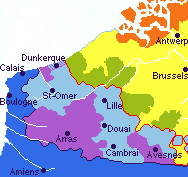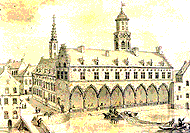History
of Flanders: ...continued
from the page on Medieval
Flanders

the
Spanish Netherlands
|
Flanders in
the Spanish Empire |
||
|
The story so
far... |
||
|
|
..with weak opposition from England .........or France |
|
 Charles Quint (or "Carlos I") ruler of Spain, the Netherlands, Austria, Germany and America - the most powerful man in Europe. |
 King Henry VIII of England (1509-1547) - France sought him as an ally at the Field of the Cloth of Gold, but he turned to Spain. When Henry split with the Pope, both France and Spain allied against him. |
 Frances I brought the Rennaissance to France. He tried to strengthen his royal rule over the lands that were supposed to be his, and feared being surrounded by Spain... |
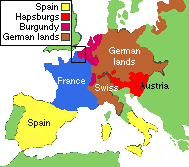 |
Charles Quint He first went to Spain as a foreigner from Flanders, not speaking a word of Spanish - but he soon regarded Spain as the most important part of his empire, and set out to create a powerful dynasty for his family, the Hapsburgs. At that time, newly-united Spain was driving out the Moors. In 1492, Columbus landed in America, and within a generation Spain had conquered the once-mighty Inca and Mayan empires. Spain was enriched by silver and gold brought back across the Atlantic by fleets of treasure ships, as well as new foods like the turkeys, potato, chocolate.... Back to top |
|
|
MAP: By 1520 France was surrounded by Spanish territories. Charles V ruled his empire as a family estate, rather than a united kingdom. Each part kept its own languages, customs, laws and forms of government. Charles travelled round, holding court in different capitals. |
Heavy taxes under Spanish rule |
|
|
Philip II inherited Flanders... |
- and a Protestant rebellion, helped by England and France |
|
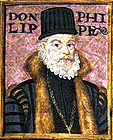 Philip II was a zealous Catholic who ruled a quarter of population of western Europe, as well as Peru, Mexico and the Philipines. |
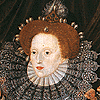 Protestant Queen Elizabeth I (1558-1603) ruled a small kingdom with a fraction of the population and resources of either Spain or France. |
|
|
|
|||||||||||||||||||||||||||||||||||||||||||||||||||||||||
|
DIAGRAM:
The struggle to rule the Low Countries |
||||||||||||||||||||||||||||||||||||||||||||||||||||||||||
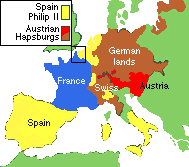 MAP: Philip II, inherited only half of his father's unwieldy empire: Spain, Flanders, and the American colonies; Charles V's brother (the Austrian Hapsburg branch of the family) took over the troubled central European parts -Austria and the German lands, where Protestantism was also rife. 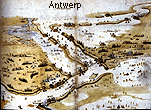 An English spy's map of Parma's siege of Antwerp - he built a huge bridge of boats across the River Scheldt to cut off Antwerp from the sea. Fighting along narrow dykes amid deliberately flooded polders in a landscape of islands, estuaries and mudflats was very difficult. |
Philip II and the rebellion of Dutch
Protestants By this time, there were many Protestants in the Netherlands. Like Louis XIV, Philip II believed it was his duty as a king "appointed by God" to fight for the Catholic church. Backed by the zeal of the Jesuits and the Spanish Inquisition, his savage repression of Protestants soon led to a rebellion that disrupted the Spanish empire in the Netherlands. Bankrupted by the cost of keeping armies in the Low Countries, the Spanish Treasury stopped paying the troops in 1575. By 1577, Dutch Protestants led by William of Orange governed virtually all the Netherlands, and demanded freedom of worship. This was too much for Philip, who raised money to send his nephew the Duke of Parma with a powerful army to regain control. Back to top In 1581 the Parma's 'Army of Flanders' started a plan to capture the rebel towns one-by-one. These were professional troops, the best in Europe. The southern provinces were soon subdued - the loyal Catholic leaders of the French-speaking towns had been uneasy allies with the Dutch protestants. By 1585, Parma had captured the key port of Antwerp, and driven the Dutch rebels back to their northern strongholds. Their situation was desperate and morale low - Queen Elizabeth sent English troops to rescue them from collapse. This angered Philip II, who sent the Spanish Armada in 1588 to escort the Duke of Parma's army across the North Sea to invade England and put a friendly Catholic on the English throne. Driven off at the sea battle of Gravelines, the Armada failed. The English and Dutch gained new confidence in attacking the Spanish at sea around the world. Spain did not agree to a truce until 1609 - and did not recognise the Dutch Republic until 1648. Back to top |
|
|
|
Prosperity of the remaining provinces |
|
|
While religious fighting continued and the Thirty Years' War (1618-48) left much of Germany in ruins, the loyal Catholic provinces in the Low Countries accepted firm Spanish rule and enjoyed a period of prosperity. Many churches were built, and poured money into commissions for religious art. Flemish artists passed easily between Holland and the Spanish Netherlands [see Flemish Art and religion]. Spanish governors gave charters empowering Flemish towns to levy taxes, hold markets, and control traders; invested in draining marshes, new canals and projects like the Exchange in Lille - the Vieille Bourse (1652) and the large squares in Arras (R). |
|
|
|
France claims Flanders... |
from the weakened Spanish; the Dutch look for allies.. |
||
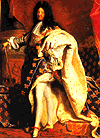 STRONG: King Louis XIV now the strongest and most ambitious ruler in Europe - took advantage of Spain's weakness to capture much of Flanders for France |
 Carlos II of Spain - the defeat of the Armada showed that Spain was not all-powerful. Defending the enormous world empire used up all the treasure from America and more. Debts piled up, and inflation and corruption further weakened the now tottering empire. |
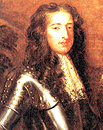 Leader of the young Dutch Protestants, young Prince William of Orange (descendant of the rebel leader assassinated by the Spanish in 1584) looked for allies to stop Louis XIV taking over the whole of the Low Countries. In 1688 he acieved this by becaming King of England... |
 WEAK: Charles II (1660-1685) - his father lost his kingdom in a Civil War and was beheaded. Charles II depended on secret subsidies from French King Louis XIV |
|
French expansion As his armies fought their way eastwards, Louis instructed his military engineer Vauban to build a chain of strong fortifications to secure his new territories. |
|
Dutch opposition The War of the Spanish
Succession |
Map: Louis XIV captured much of Spanish Flanders - in 1670, he reached the southern parts of Holland. The peace treaty in 1713 left Flanders divided by an artificial border |
||||||||||||||||||
|
Treaty of Utrecht 1713 |
|||||||||||||||||||
|
|
|||||||||||||||||||
|
Napoleon
re-unifies Flanders |
|||||||||||||||||||
|
What
happened to Flanders in the after
Napoleon? |
|
Places to
visit: |
|
Background information |
|
|
|
|
|
|
|
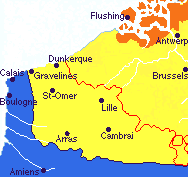
 INVESTMENT:
Vieille Bourse in Lille, an exchange for the cloth merchants
- built 1652, a legacy of Spanish rule.
INVESTMENT:
Vieille Bourse in Lille, an exchange for the cloth merchants
- built 1652, a legacy of Spanish rule.
